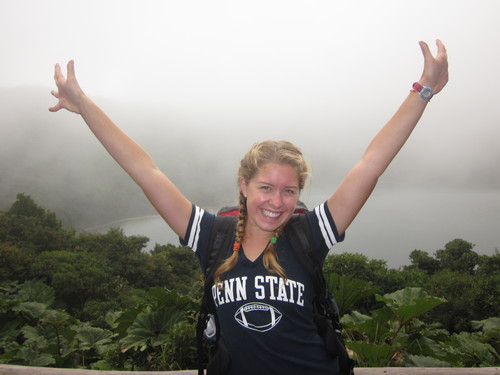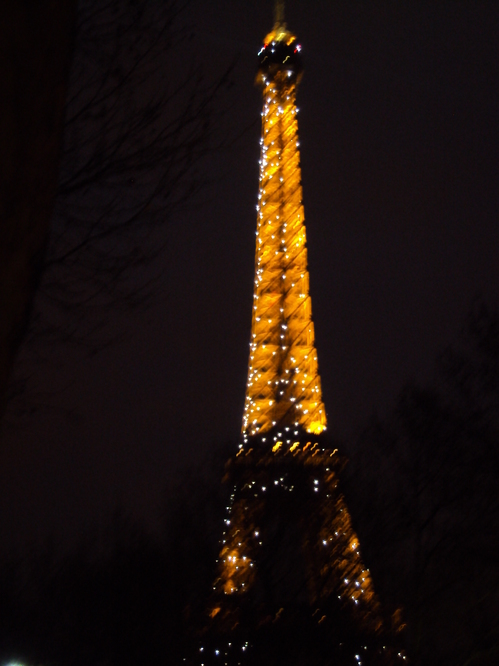Location: Poas, Costa Rica
Tag Archives: cultural preservation
They Made Me an Offer I Couldn’t Refuse
Realizing that my time in London is starting to come to an end is really depressing. But I’ve started to take more advantage of living so close to Europe (apparently Brits don’t count themselves as European) by spending the last couple of days in Pamplona with my favorite Godsister Maria. With a flight out of London Luton at 6 in the morning, I decided not to sleep the night before so I could walk to Victoria Coach Station to get the 3 AM bus to the airport, where the display book of the week was… Stardust. I kid you not. Naturally I bought it and read it before landing in Madrid. If you want to read it I warn you that it is not anything like the movie.
Pamplona was a glorious 30+ Celsius when I met Maria, who caught me up with all the Navarra gossip, before seeing my wonderful Godfather Emilio, Maria Jesus, Maria’s Abuela and Suna! In the five minutes of arriving, I quickly changed into Maria’s clothes, because they are better than mine, and went to watch Maria and her radio friends do a broadcast.
That night Maria and I played dress up, and went out to a long, nice dinner with 30 people who work with her, and had a several hour meal. After each course I kept thinking how proud my Daddy would’ve been, especially as I ate jamon! As Maria tells me, I’m not a vegetarian in Spain. For some reason that girl can make me do anything.
 After trying desperately to understand Spanish for the better part of three hours, and trying really hard not to fall asleep after being awake for 40, the group went out dancing, which fortunately I can do on autopilot. Around 4 in the morning some of Maria’s friends that I knew from spending last summer in Pamplona came out, and we had a massive jumping reunion, and decided that they should probably soon call my Dad to plant the idea of taking me back to San Fermin this year. But the night did not go entirely smoothly, as between 5:17 and 5:30 my US phone was taken. I immediately went looking for it, and called it with my London phone, where someone answered and told me they had no intention of letting me have it back. But we got back to Maria’s house at 6:30 in a thunderstorm when my US phone called Maria, and later Jokin, Ali, Hilary, Kristen and God only knows who else.
After trying desperately to understand Spanish for the better part of three hours, and trying really hard not to fall asleep after being awake for 40, the group went out dancing, which fortunately I can do on autopilot. Around 4 in the morning some of Maria’s friends that I knew from spending last summer in Pamplona came out, and we had a massive jumping reunion, and decided that they should probably soon call my Dad to plant the idea of taking me back to San Fermin this year. But the night did not go entirely smoothly, as between 5:17 and 5:30 my US phone was taken. I immediately went looking for it, and called it with my London phone, where someone answered and told me they had no intention of letting me have it back. But we got back to Maria’s house at 6:30 in a thunderstorm when my US phone called Maria, and later Jokin, Ali, Hilary, Kristen and God only knows who else.

Later that day, after sleeping for about 3 hours I returned to my running route around Pamplona, back to exploring the ruins of the fortress and already missing it knowing that I would have to leave soon. We meet one of Maria’s friends for a drink at an English pub, and then went out with some of her school friends for an awesome nachos dinner.

The next morning we woke up at 9 which seems ungodly early there, and set out for Huesca where we would get to visit Jokin! The drive was absolutely breathtaking, and I wanted to stop every five minutes to hike and explore. But as we were wearing heels and dresses and Maria isn’t the number one hiker this hardly seemed like the best idea. Jokin’s apartment is absolutely amazing and palatial, and it smelled like the incredible roast chicken that inexplicably had a can of beer stuffed inside of it. Maria made a squid paella (in it’s own ink!) and we had a great lunch before Jokin had to leave for his game. Maria and I went an hour later (after having an adventure hiking across a field) to our special players

section seats, practically on the field. The game was really good and ended a tie, even though a goal was disallowed that would have won it for Huesca. After the game Maria had to do a phone interview broadcast, and we had a magical WAG moment when we sped away from the field in Jokin’s car.
That night we watched the Osasuna game from the radio station and it was incredible to see. I have a completely new respect for sports broadcasters. Not that I could understand anything, they were talking so quickly my head was spinning. Since I had to leave early in the morning, and Maria had an exam the next day, we went back to her house and had a late dinner celebrating the last time I’d eat meat until I go back to Spain.
I was sad not to have been able to see my other wonderful Godfather Eduardo and Ana, and their grandson Javier, clearly I’ll have to go back soon and make amends.
Welp, I have to finish my last essay before leaving for Paris tomorrow with Caitlin, so I’m theoretically going to stop listening to my new favorite Spanish music and get back to work. I’ll leave you with some of the songs though, and you can have your own dance parties. Just imagine I’m there too please.
Location: Pamplona, Spain, Navarra
“A mini break means true love.” -BJD
I’ve begun to realize that my time abroad is coming to an end although it’s been so long since I’ve had a class that just seems wrong. In other things that seem wrong, the days off the UK gives for just about anything, (although I’m not in any place to complain as my only work is studying).
Last weekend we had off Good Friday and Easter Monday. I understand Friday, but I’m convinced Easter Monday is just a made-up thing. This past weekend the nation was given off Friday for the Royal Wedding. That one is a stretch, but I understood after millions of people flocked into the city, basically shutting down massive areas of London. What I do not understand is getting off the following Monday to continue the celebrations. But it did mean that I got to spend another weekend as The Three Best Friends That Anyone Could Have. By which I mean myself, Matt and Mo. We went to Devon Friday afternoon to stay with Matt’s sister Bec, his brother Rob, and his favorite 4-legged family member Diesel.
After getting in, we quickly changed into dress-up clothes and went to some sort of charity/opening/royal party event, complete with harpists and several piece orchestras and heralds that gave us royal titles. I became Claire Princess of Pennsylvania; I’ll allow you all the opportunity to bow down to me later. We had a wonderful time and closed several lounges before making a late return to Bec’s.
We spent the next morning lying on the beach and recovering, and Momo and I swam in the ocean, regardless of the freezing water without wet suits like everyone else. Several people commented on our ‘braveness’ which I take is BritCode for stupidity, and assured of after Momo had turned gray.
After the beach everyone was ready to have a barbecue, only to realize that there was no grill. While this would have ended all of my hopes of eating except possibly microwaved porridge, the Smiths were genius enough to put together a grill by playing the game ‘grill made out of things in the shed’. As Momo pointed out, the Smith family and anyone connected to them are capable of making anything, only to point out that we were clearly the exception.

The next afternoon we went to the village Clovelly, which was on at least a 45 degree angle to the water’s edge. I tried my first real Cornish pasty, and have since developed a taste for potato, cheese and onion filled pastry. Afterwards, two of the Bec’s friends from Wolverhampton came with their one-year-old son, who seemed incapable of being unhappy. We went out for Cream Tea (which is actually tea and scones with cream), although for the second time in a week Momo and I committed a faux pas and drank coffee instead of tea at tea time. I learned to differentiate ‘going for tea’ and ‘having tea’… No, wait, no I didn’t. Only that one means dinner and the other means proper tea.

The next morning while Momo and I were making ourselves breakfast we heard the unmistakable sounds of a certain soundtrack coming from the living room only to find that Rob was kind enough to put on Stardust (obligatory mention), as we had talked about it non-stop since the mini-orchestra had played the theme, and we’d insisted on reenacting the gatekeeper scene at every stone wall. We then went back to the beach to teach Harry to like sand and picnics before packing up and heading back to London. Our way back was lousy with traffic, and what had been a three-hour ride down was nearly doubled on the way back. The pluses were our impromptu dance party on the side of the motorway and a slow-moving view of Stonehenge, which I can now cross off my list!
Location: Devon, Cornwall, Clovelly, Stonehenge
More than just a tourist
I have been in Paris for almost two weeks now and am finally starting to feel like I belong here. I mastered the Paris metro, at least most of the lines and am starting to feel like a true Parisian. By this I mean having only tea or coffee for breakfast, staring down at my feet or into a book while on the metro (because if you smile at someone, it means you are interested in them), walking around with a baguette for lunch, and wearing a scarf everywhere I go because it’s the style (for both women and men).
Location: Paris, France
Czechin’ Out Prague
Studying abroad constantly shows me how little I know, how limited my knowledge of the world’s history and cultures is. In American schools, we learn about our own country’s history over and over, year after year, without ever expanding our understanding of what was going on elsewhere.
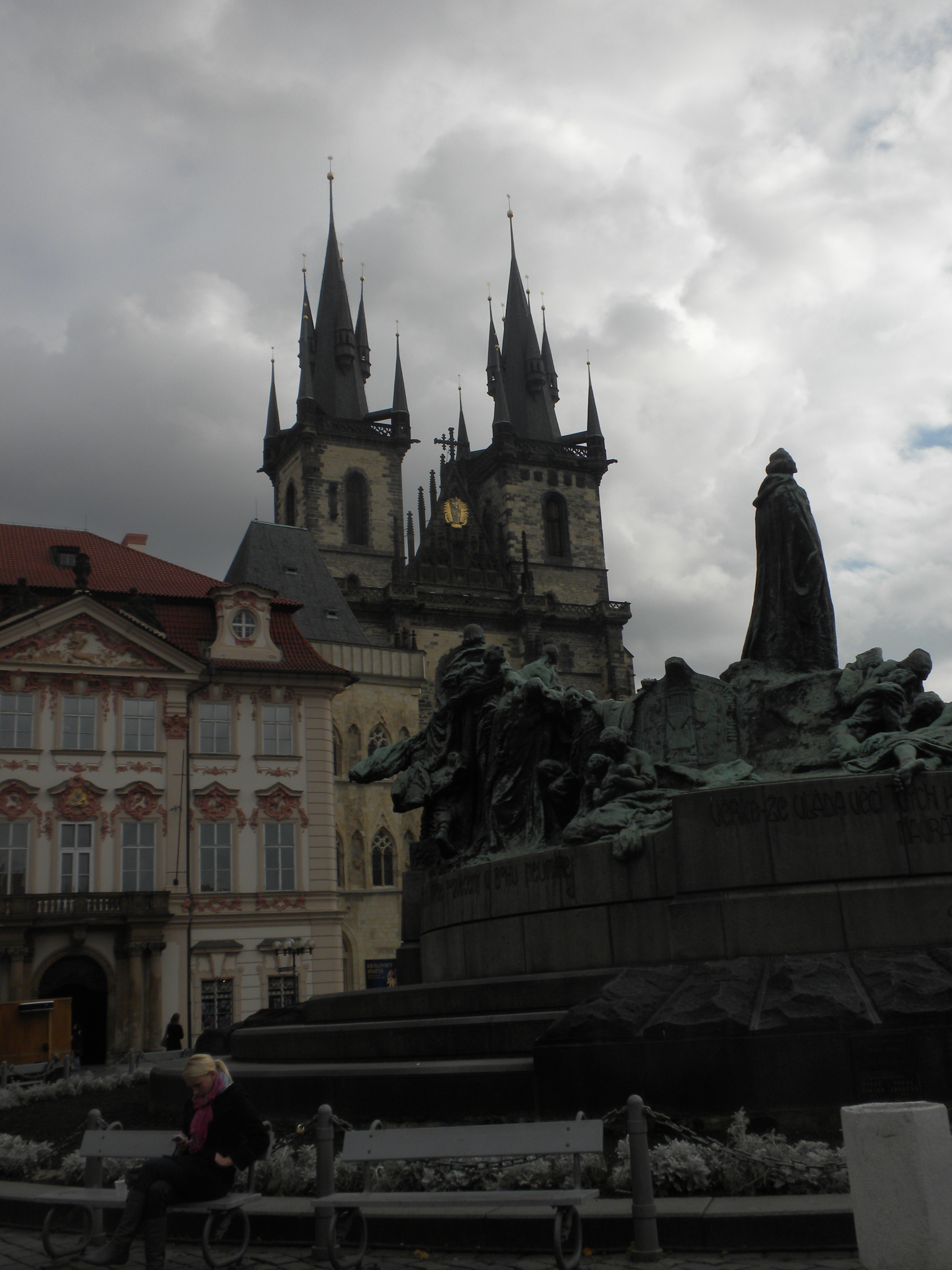
This week I spent three days in Prague, in the Czech Republic. Prague is a beautiful city with a rich past: it’s been the home of Germanic and Slavic tribes, the Holy Roman Empire, the Hapsburg Empire, the Nazis, and the Soviet communists during the Cold War.
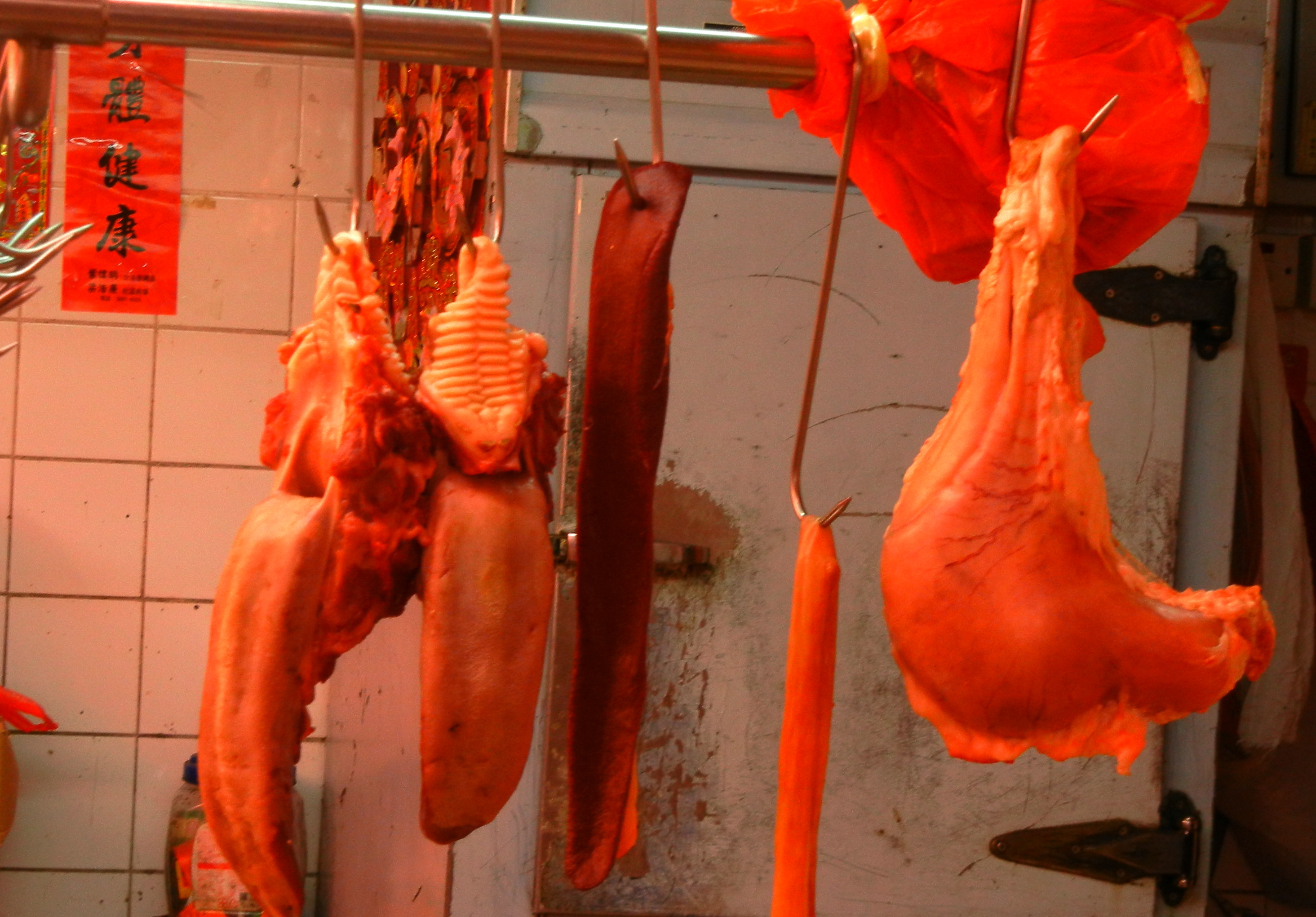
We took a three hour walking tour of the city and visited the Museum of Communism, located ironically next to a McDonald’s. I learned just how ignorant I was of the Czech Republic’s history – I had no idea under what circumstances it had lain after World War II until the Velvet Revolution in 1989, or how it had evolved from Czechoslovakia. In the Museum of Communism we watched a video that explained the various uprisings and demonstrations that led to the fall of Communism. Seeing the footage of police brutality and the lengths the government went to in order to suppress the Czech people was striking.
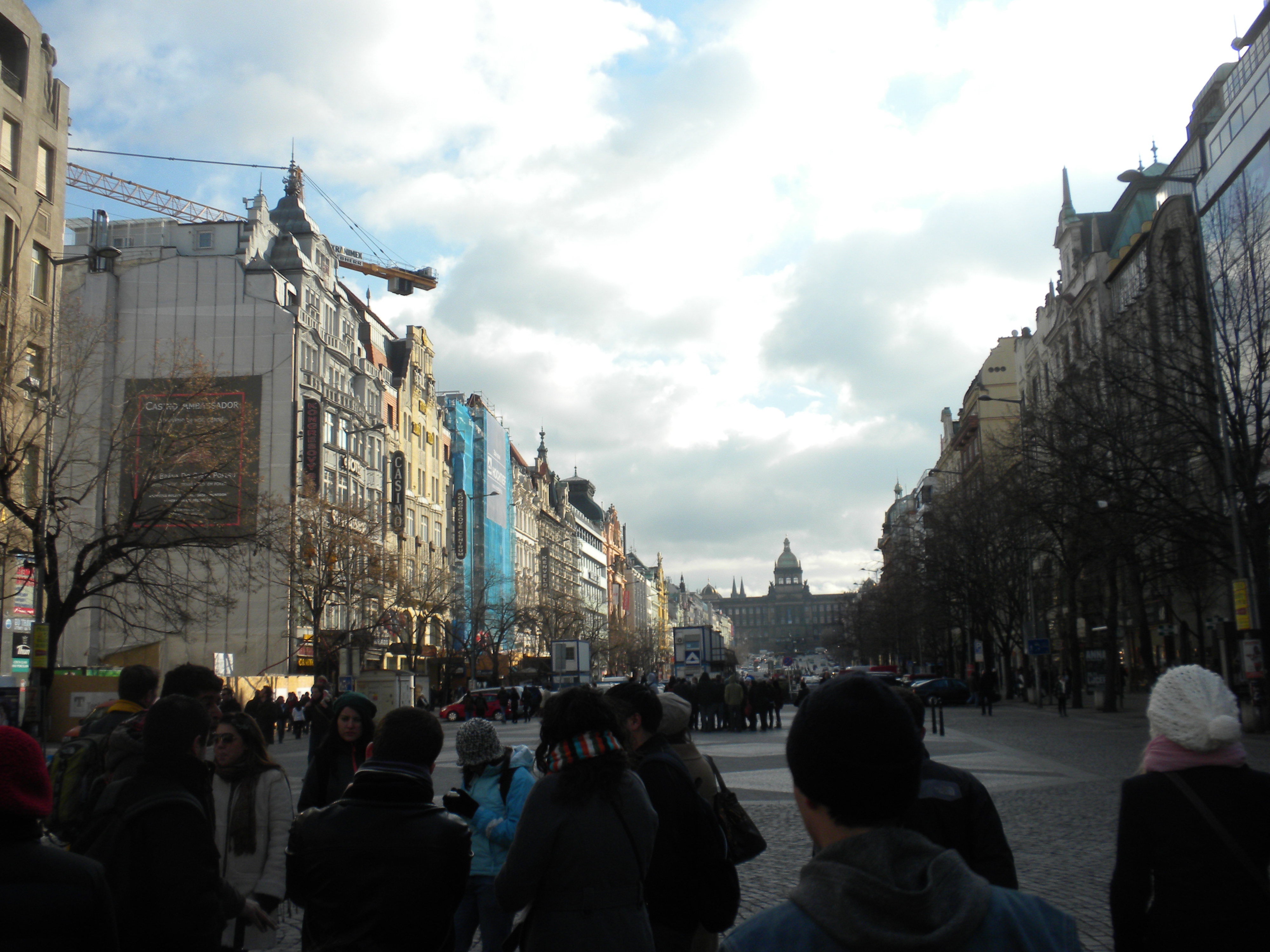
Being surrounded by this saturation of history is one of my favorite parts about studying in Europe. Every street I walk on has seen hundreds (if not thousands) of years of human civilization. I have five weeks left to soak it all in before I leave Paris for Pennsylvania. Time is spinning quickly.
Location: Dělnická 24, 170 00 Praha, Czech Republic
Chantilly
On Saturday IES hosted an excursion to the Ch�teau de Chantilly, a castle in the Picardie region outside of Paris. Although some parts of the original buildings are no longer standing, the castle was constructed in 1560 for the princes of Cond�. Today the castle is more of an art museum, hosting the Mus�e Cond� and its collection of paintings that’s said to rival the Louvre. And of course, Chantilly is home to the famous Chantilly cream, lace, and racecourse.
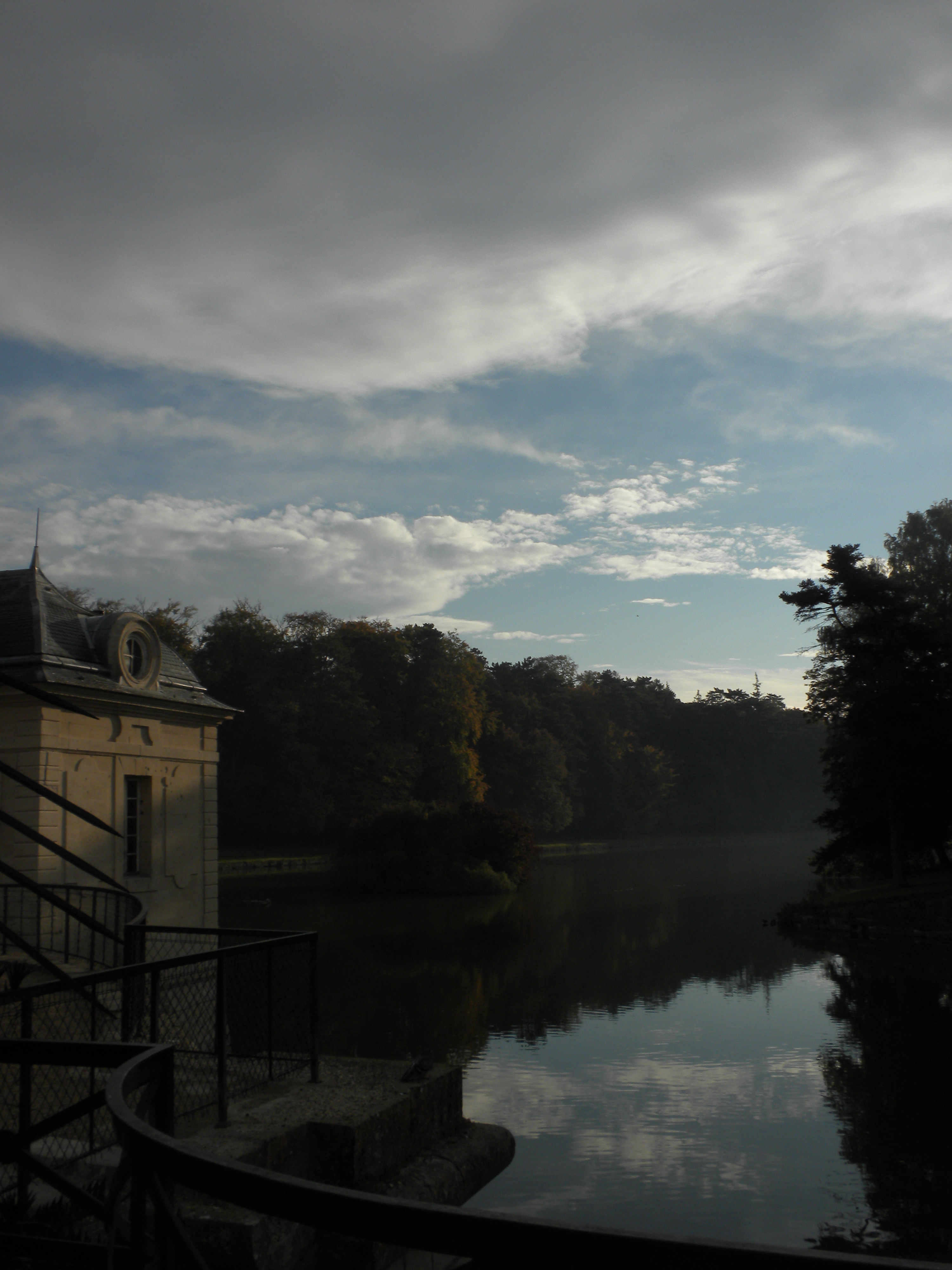
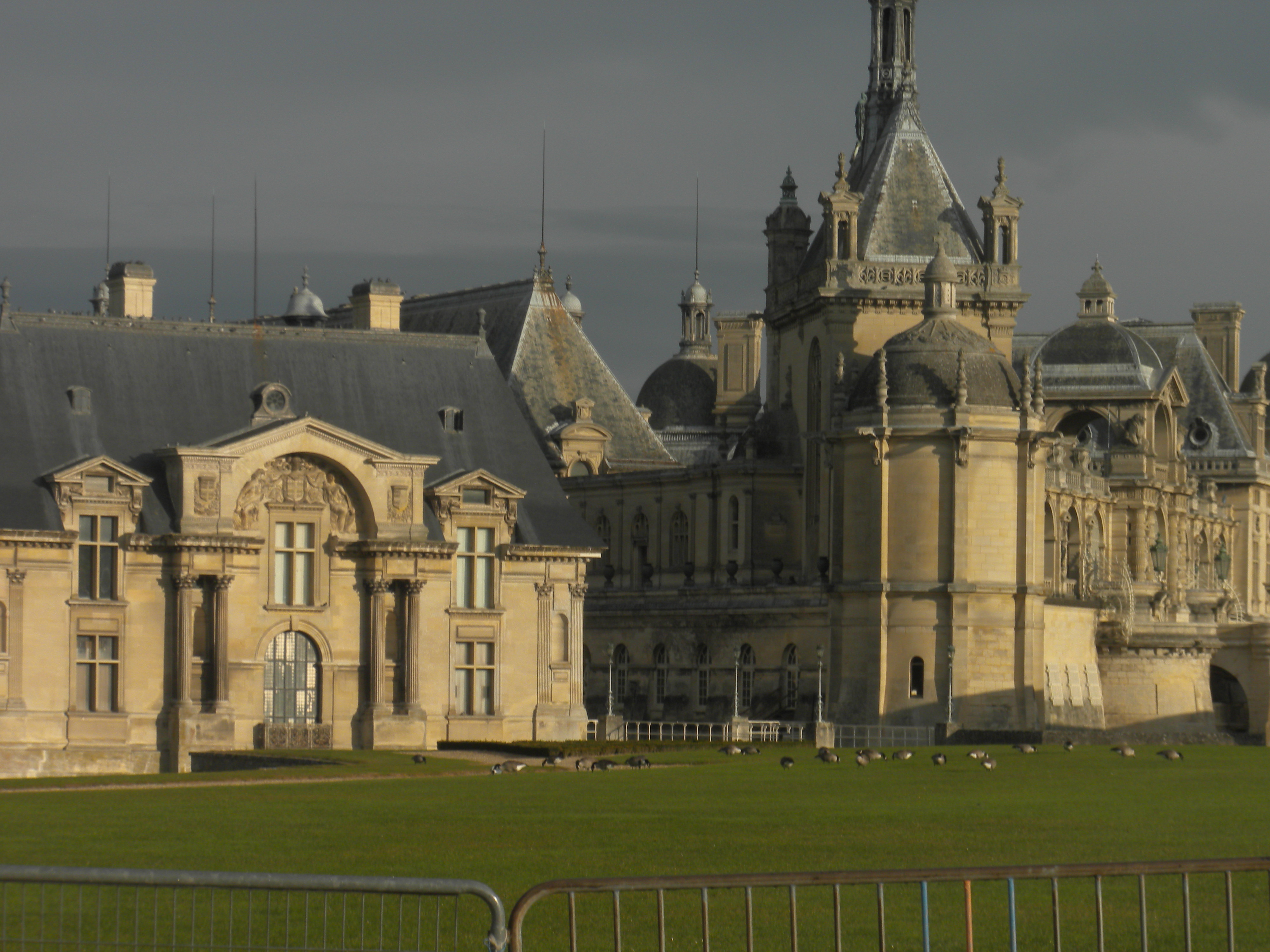
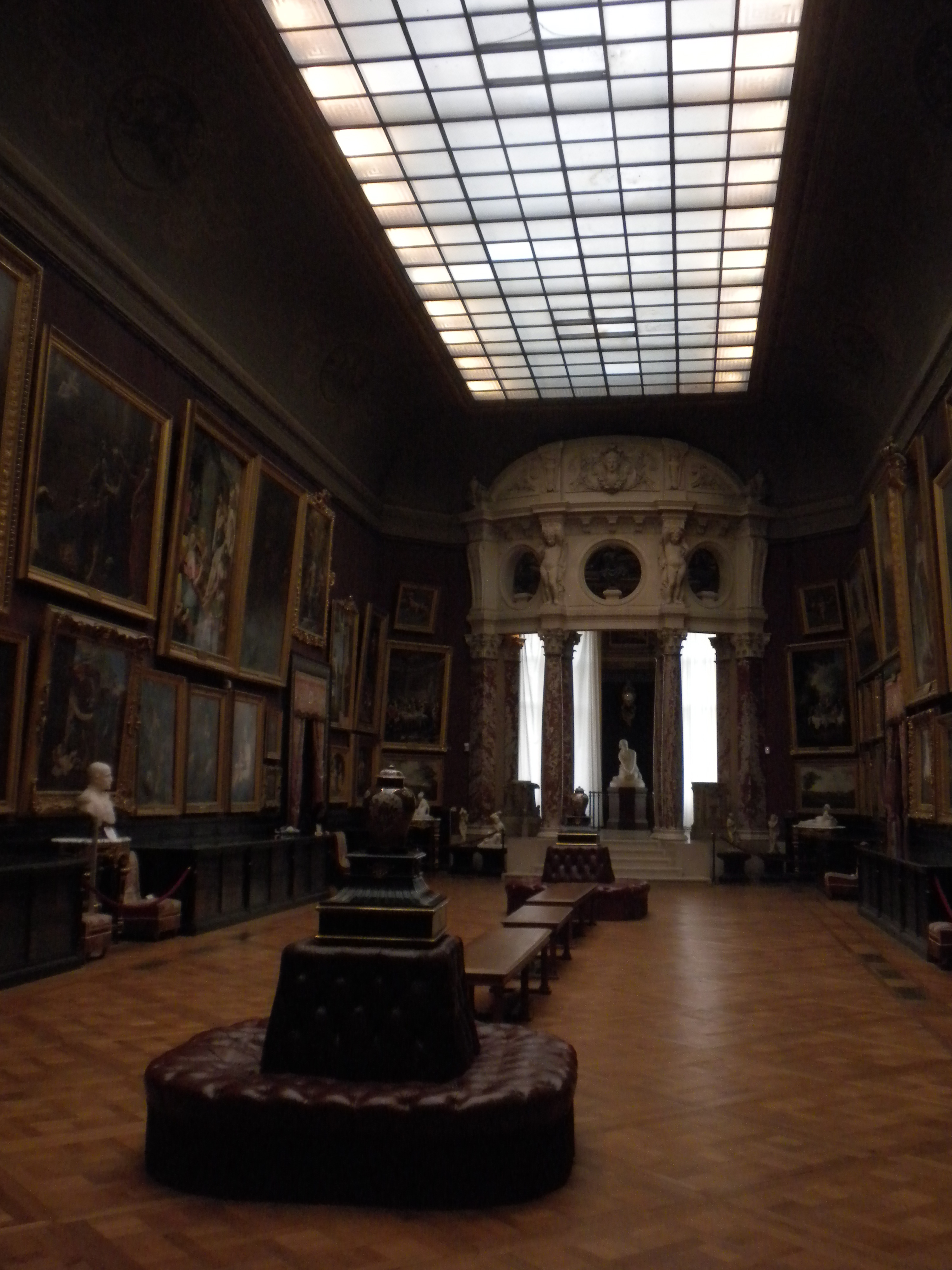
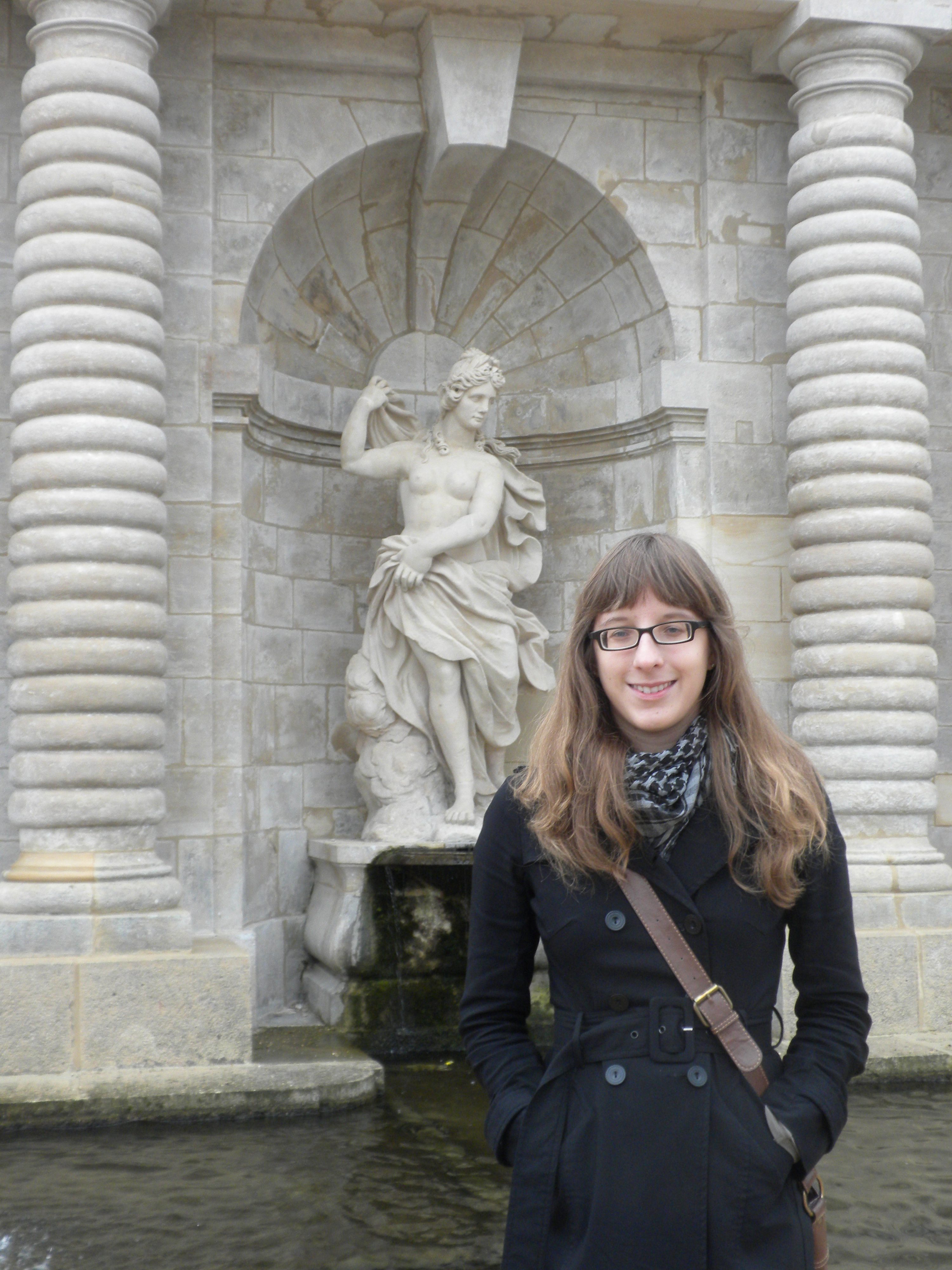
Location: Château de Chantilly, France
A Night at the Opera
A couple months ago, I was looking through my grandparents’ old house. While shuffling through dusty piles of letters, papers, and family photographs, I came across an envelope full of little pictures. They were photographs my grandfather took during World War II when he was stationed as a soldier in France and sent home to my grandmother. On the back of each, he wrote dates, names of people and locations, and often a comment. He wrote on the back of a picture of the Palais Garnier, where the Op�ra National de Paris shares its home with the legendary Phantom, that he would have loved to see a performance there, if he ever came back. He was a musician himself and he loved classical music and opera; it would have meant a lot to him. He never got that chance, so I decided that I would go instead.
Last night there was a salon of classical music – a string quartet played Schumann and a string/woodwind octet performed pieces by Hindemith, a more contemporary composer. While the music was good and the musicians extremely talented, I enjoyed seeing the Palais Garnier more than anything. The ornate decorations, the balconies, rich red curtains, and paintings on the ceiling made it feel like stepping back a hundred years or so. The building is immense, too; you enter through two grand halls before even coming to the theatre. Of course, I came in through the backdoor with the rest of the poor students buying last-call tickets ten minutes before the show. But still, it was cool (and worth the 10 euros).
And although my imagination was working hard and wishing for it, the Phantom didn’t show up. Maybe he only makes an appearance for actual operas.
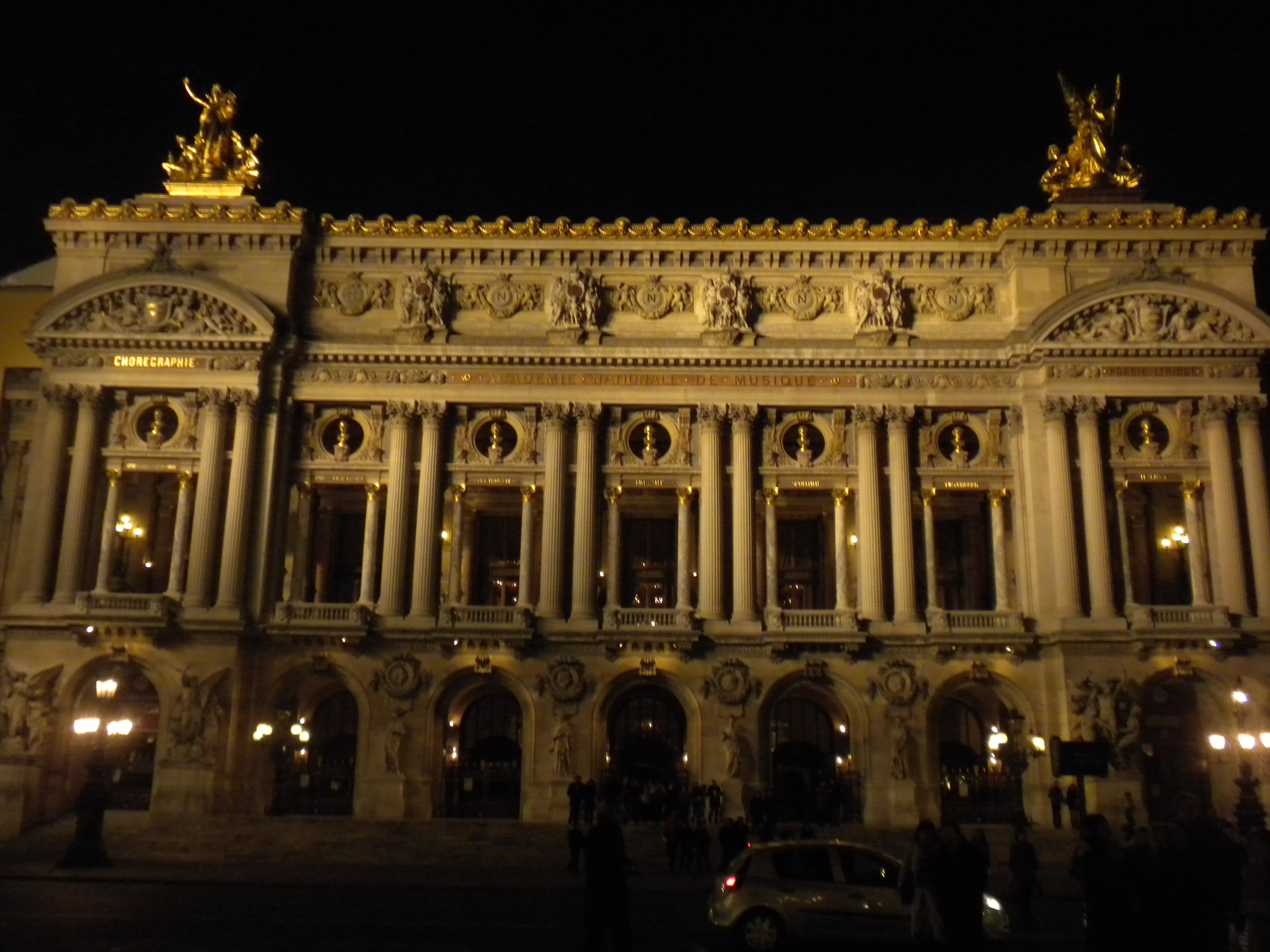
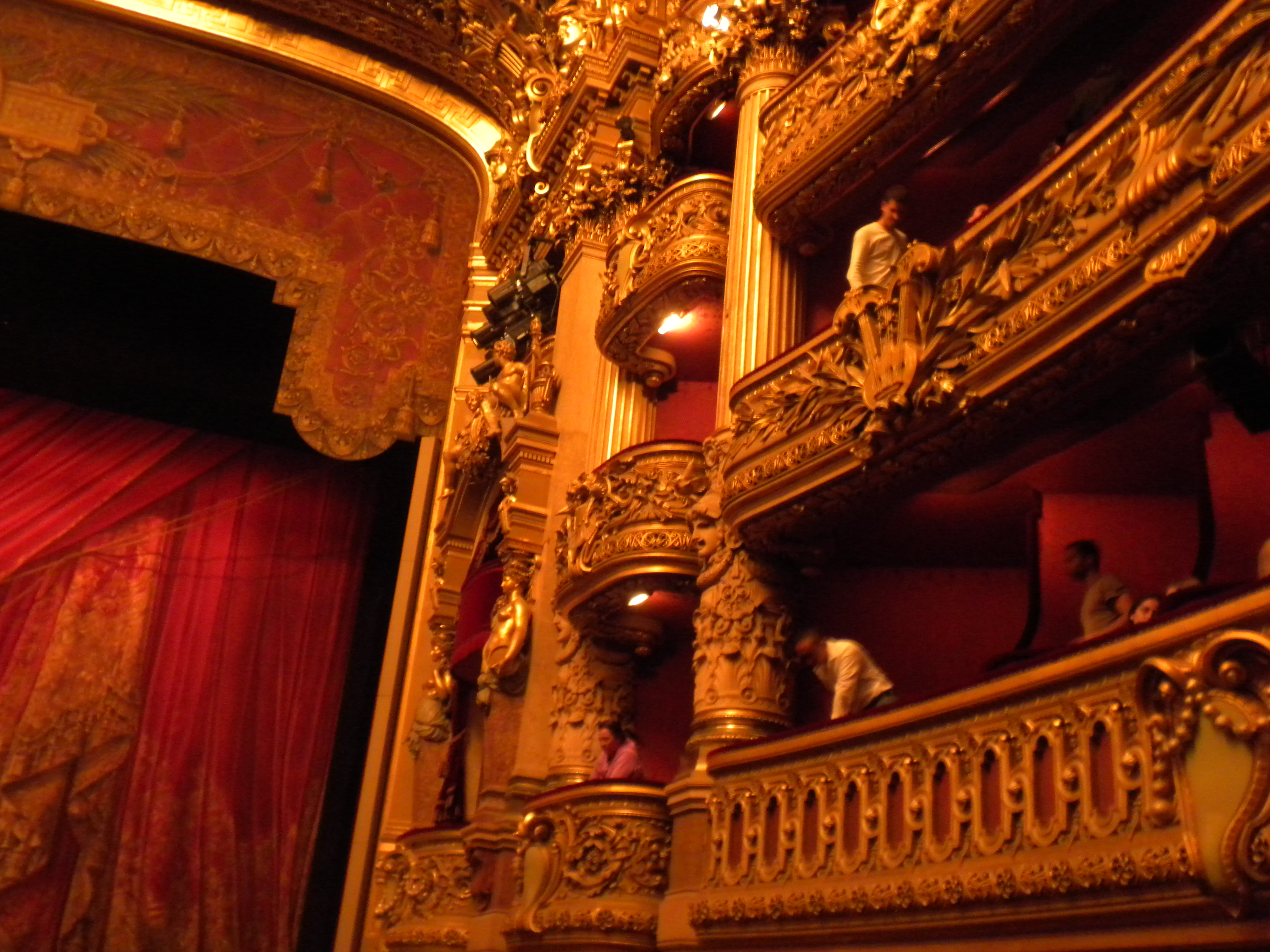


Location: Place de L'Opéra, Paris, France
Climbing through Cappadocia
The study tour around Cappadocia began with a trip to the Goreme Open Air Museum. Goreme was once a city which was carved into the Tufa stone that covers this area. There were actually people living in this town until the Turkish government had them move a little bit away from the site, so that the site would not be damaged anymore by daily living. 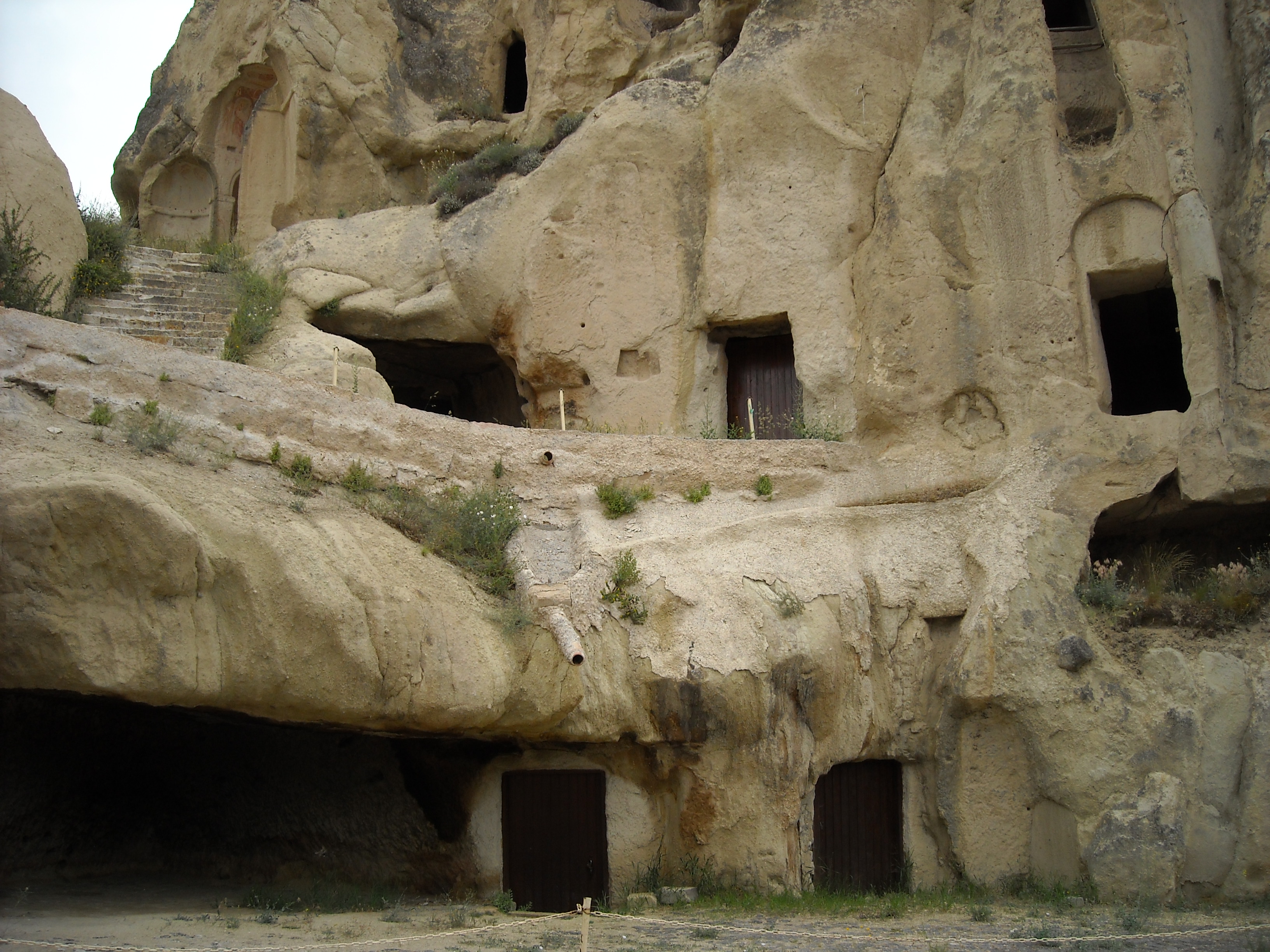 This is the area of Turkey where monasteries first came into use in the Christian world. The Christian priests believed that if one were to separate themselves from the daily life as experienced by others, then there would be less chance for them to sin. This was a measure taken to protect their innocence and untainted souls. Goreme was carved out around the Byzantine Period, and shows signs of the art from this period in the churches that are abundant at this site.
This is the area of Turkey where monasteries first came into use in the Christian world. The Christian priests believed that if one were to separate themselves from the daily life as experienced by others, then there would be less chance for them to sin. This was a measure taken to protect their innocence and untainted souls. Goreme was carved out around the Byzantine Period, and shows signs of the art from this period in the churches that are abundant at this site. 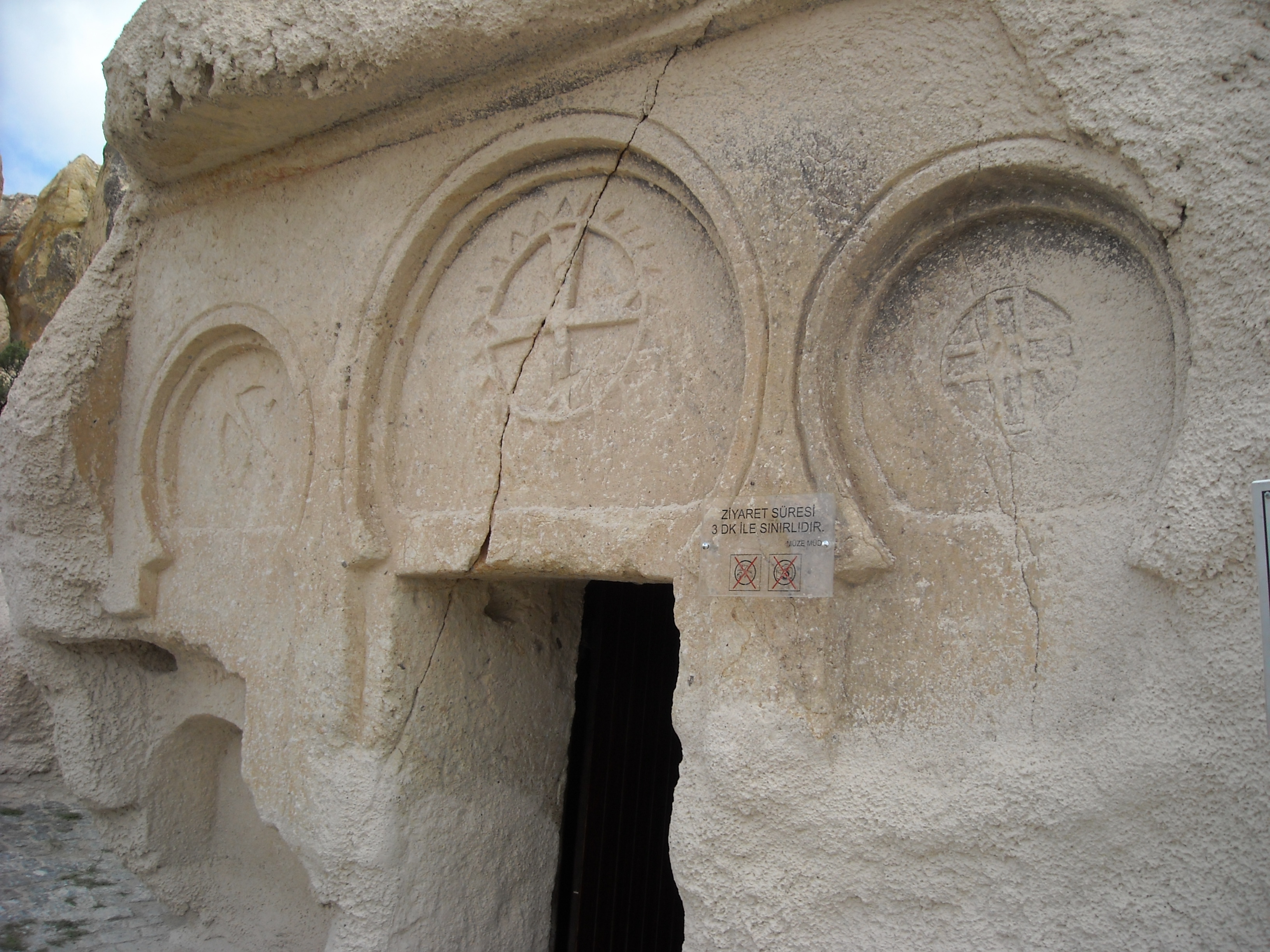 We went into several churches, and we were able to see the difference between the frescos done by professionals and nonprofessionals. In most of the churches at this site, there was a Cappadocian cross. There was also the repeated image of the stylized version of Jesus on the cross with the two thieves beside him. This site did amaze me, however, due to the fact that all of these places were carved into the rock. There was thought about how the space was going to be used, and what had to be left so that more details could be put to use later.
We went into several churches, and we were able to see the difference between the frescos done by professionals and nonprofessionals. In most of the churches at this site, there was a Cappadocian cross. There was also the repeated image of the stylized version of Jesus on the cross with the two thieves beside him. This site did amaze me, however, due to the fact that all of these places were carved into the rock. There was thought about how the space was going to be used, and what had to be left so that more details could be put to use later. 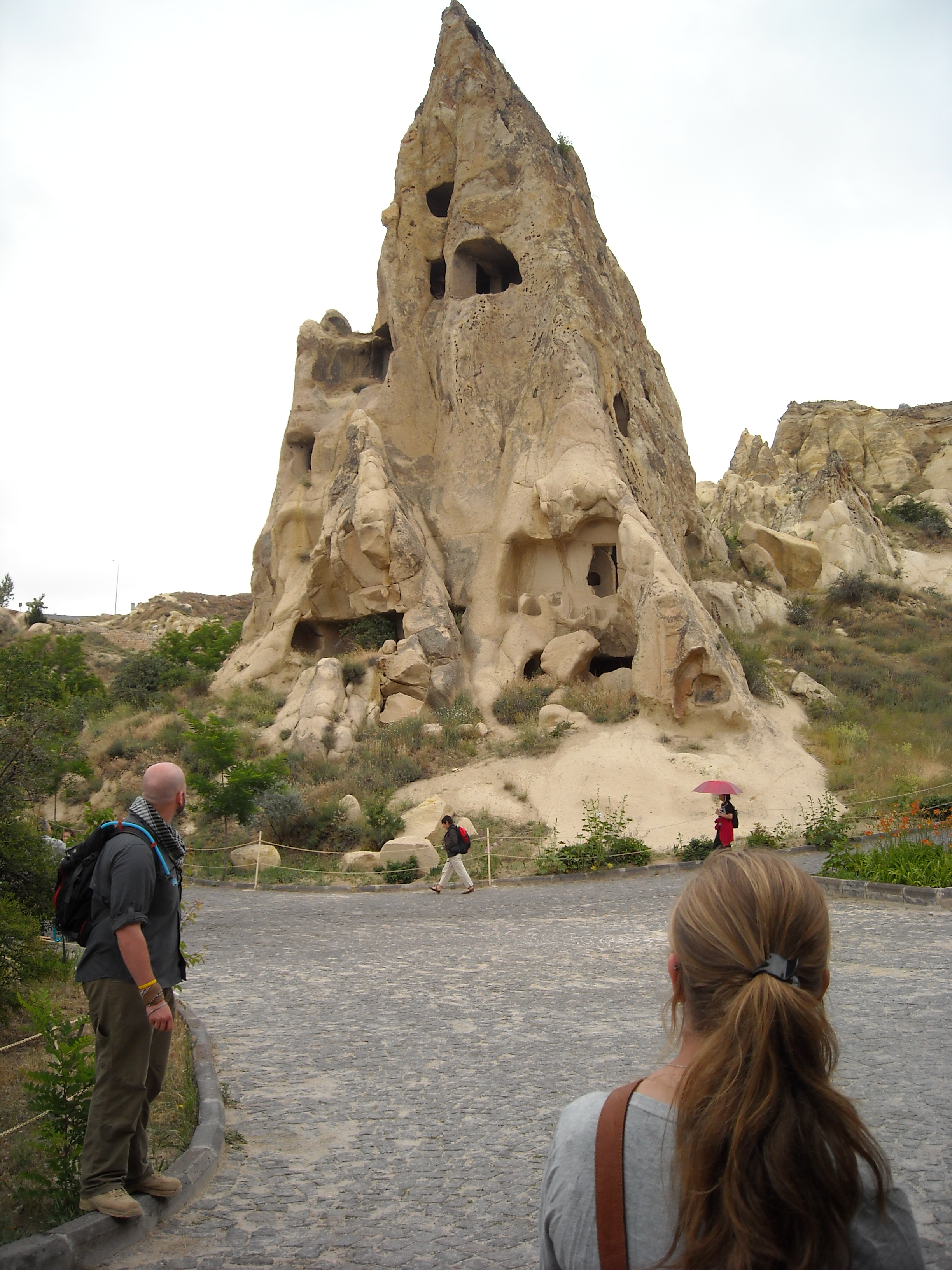 Goreme is also a UNESCO world heritage site. As we walked through this site, I felt like it would be difficult to live in this village. Everyone would have to live close together, and as you walked through an area, it wore down and became slicker, and harder to walk over. I could see myself falling from one of the buildings and doing some damage to myself.
Goreme is also a UNESCO world heritage site. As we walked through this site, I felt like it would be difficult to live in this village. Everyone would have to live close together, and as you walked through an area, it wore down and became slicker, and harder to walk over. I could see myself falling from one of the buildings and doing some damage to myself.
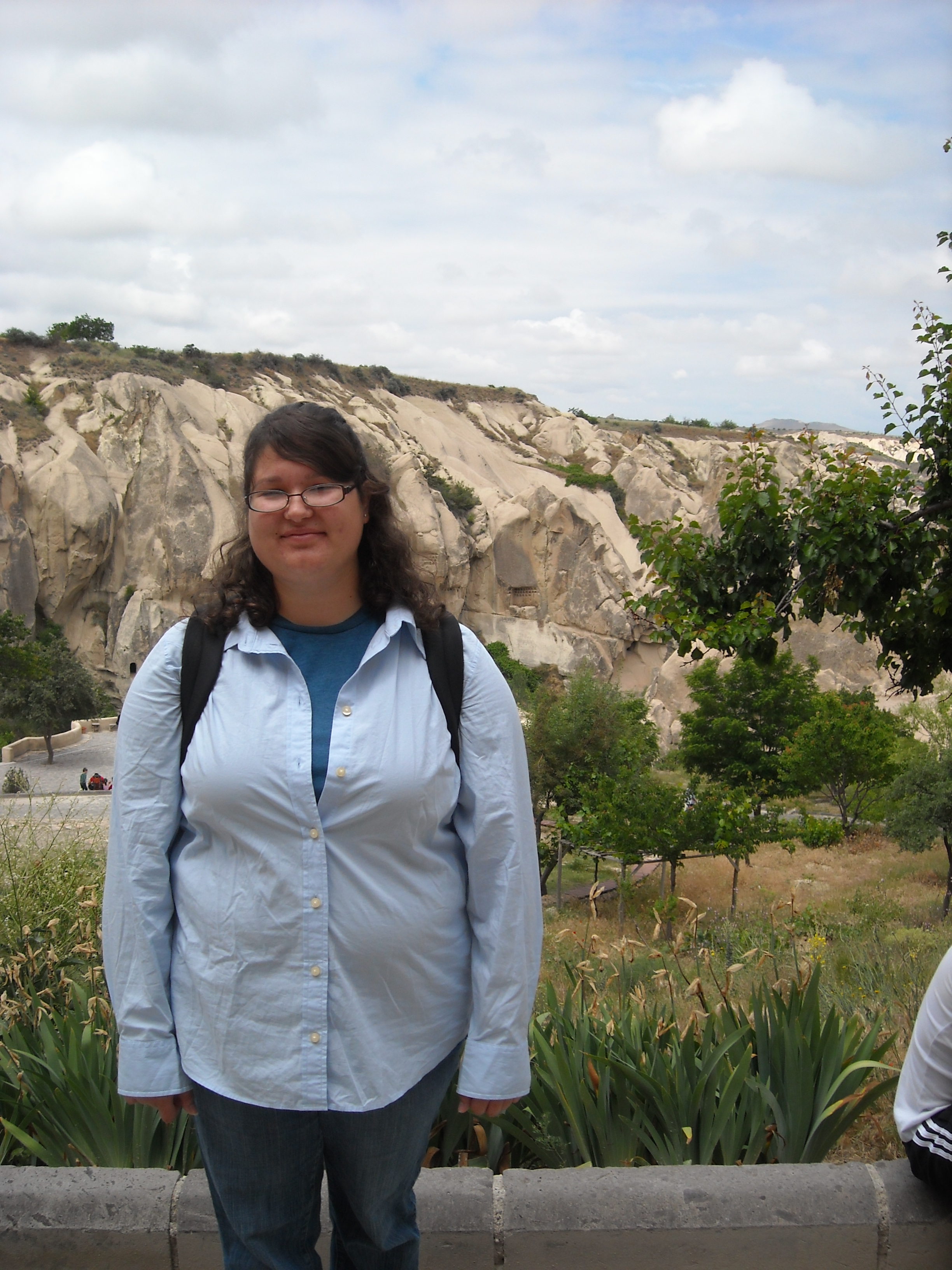 After we went to Goreme, we went to the underground city, Derinkuya. This is a city that was formed by slowly scooping away at the Tufa stone which makes up most of this region. The city is well protected with mill stones, which would be used to close off passage ways, as well as having a good communication system within the city. Not only did the city have defenses, but the layout of these cities are not exactly easy to follow, and if you did not know where you were going, one could get very lost in the winding passageways.
After we went to Goreme, we went to the underground city, Derinkuya. This is a city that was formed by slowly scooping away at the Tufa stone which makes up most of this region. The city is well protected with mill stones, which would be used to close off passage ways, as well as having a good communication system within the city. Not only did the city have defenses, but the layout of these cities are not exactly easy to follow, and if you did not know where you were going, one could get very lost in the winding passageways. 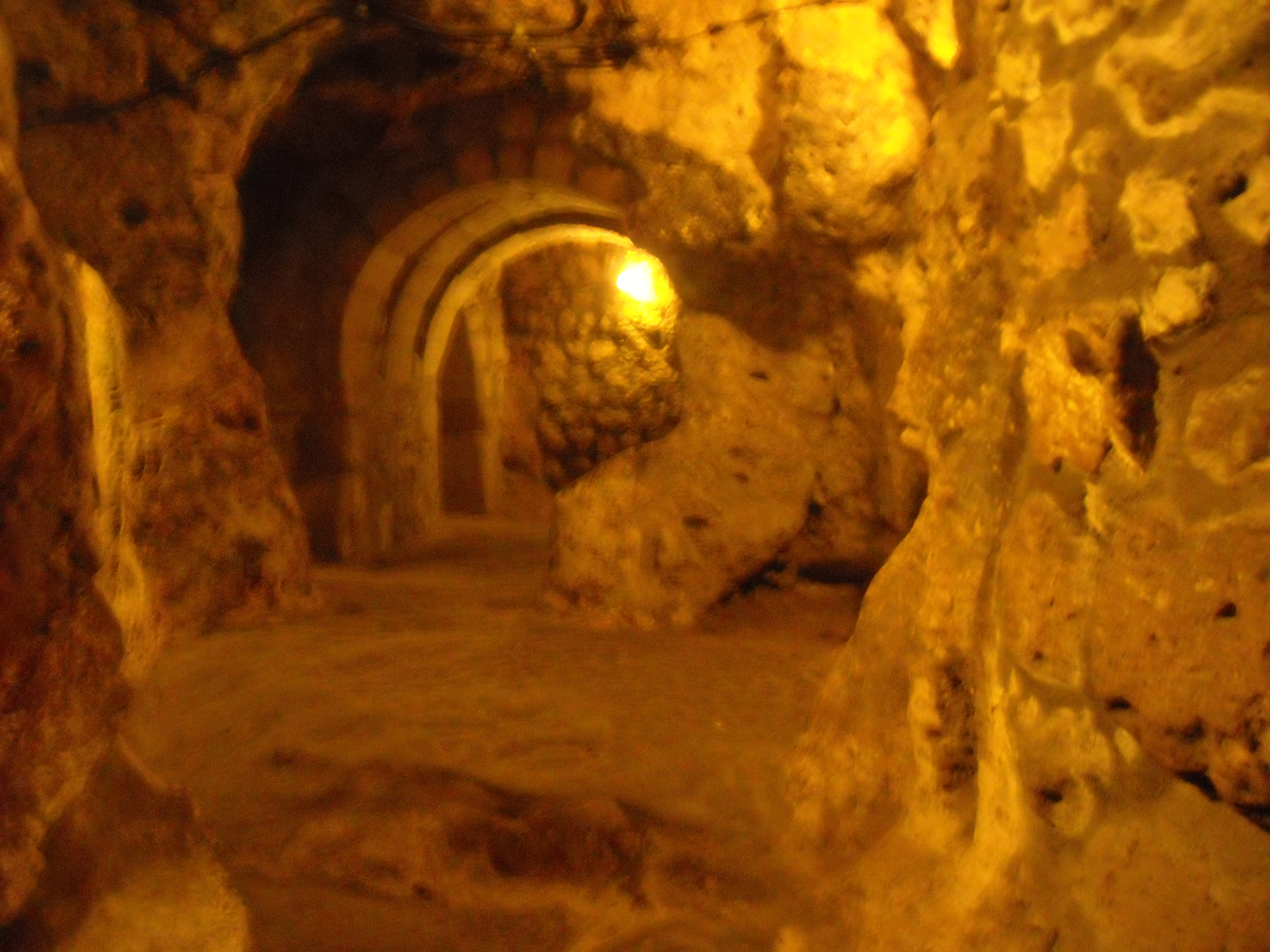 Derinkuyu was not just storage and housing, but it also had a church in the bottom level in the shape of an Assyrian Cross (slightly bent at the top, because they say that as Jesus died, his head leaned to one side). In the cross shaped church, a gallery was set up, which contained photos of the landscape in various parts of Turkey.
Derinkuyu was not just storage and housing, but it also had a church in the bottom level in the shape of an Assyrian Cross (slightly bent at the top, because they say that as Jesus died, his head leaned to one side). In the cross shaped church, a gallery was set up, which contained photos of the landscape in various parts of Turkey. 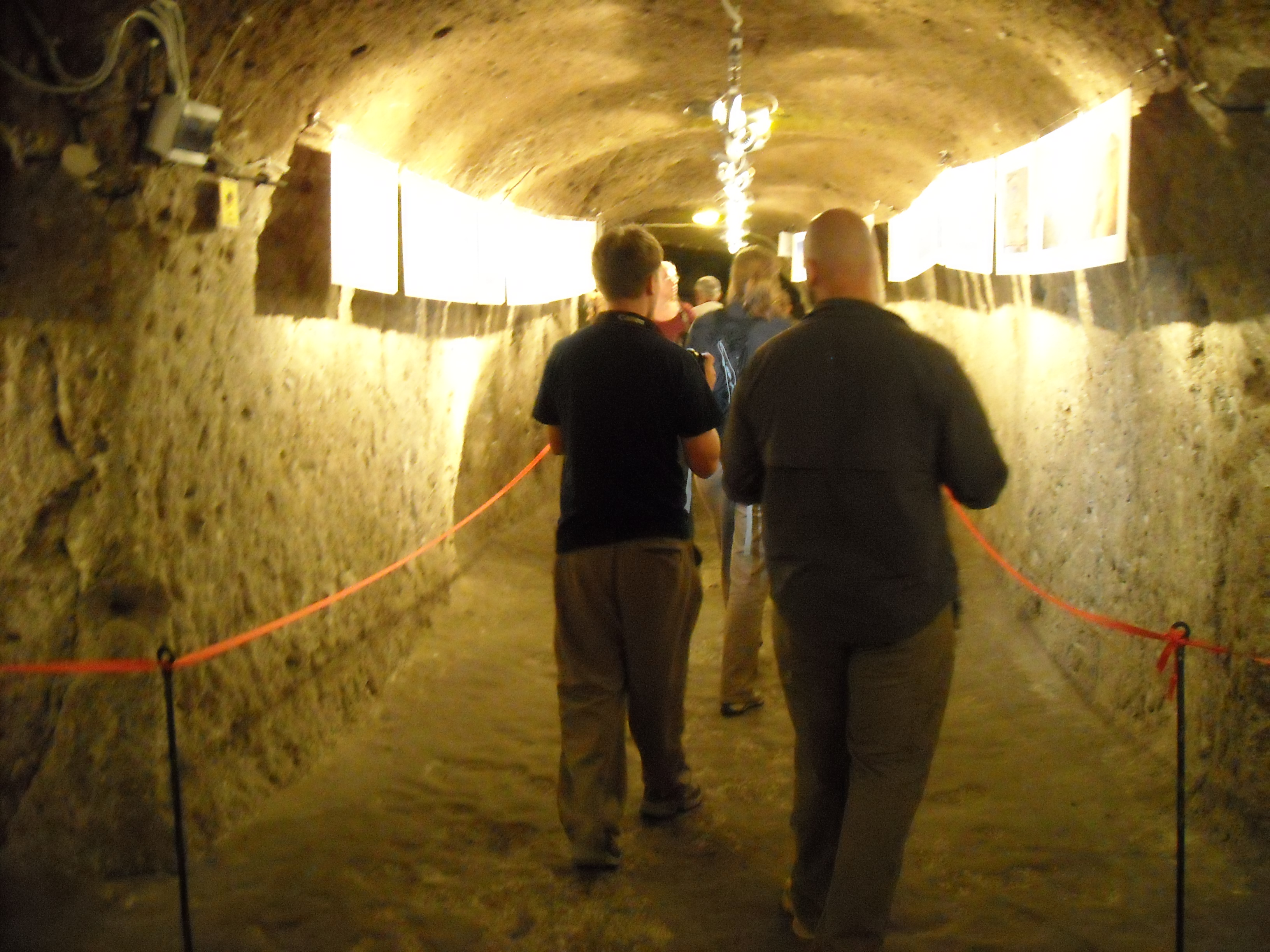 As we walked around in the site, there were times when it was less walk and more crawl and bend. The tunnels at the site can get pretty narrow, and the ceiling seems to get closer and closer to the ground as the tunnel continues. Sometimes I wonder how people were able to get through these passages on a daily basis.
As we walked around in the site, there were times when it was less walk and more crawl and bend. The tunnels at the site can get pretty narrow, and the ceiling seems to get closer and closer to the ground as the tunnel continues. Sometimes I wonder how people were able to get through these passages on a daily basis.
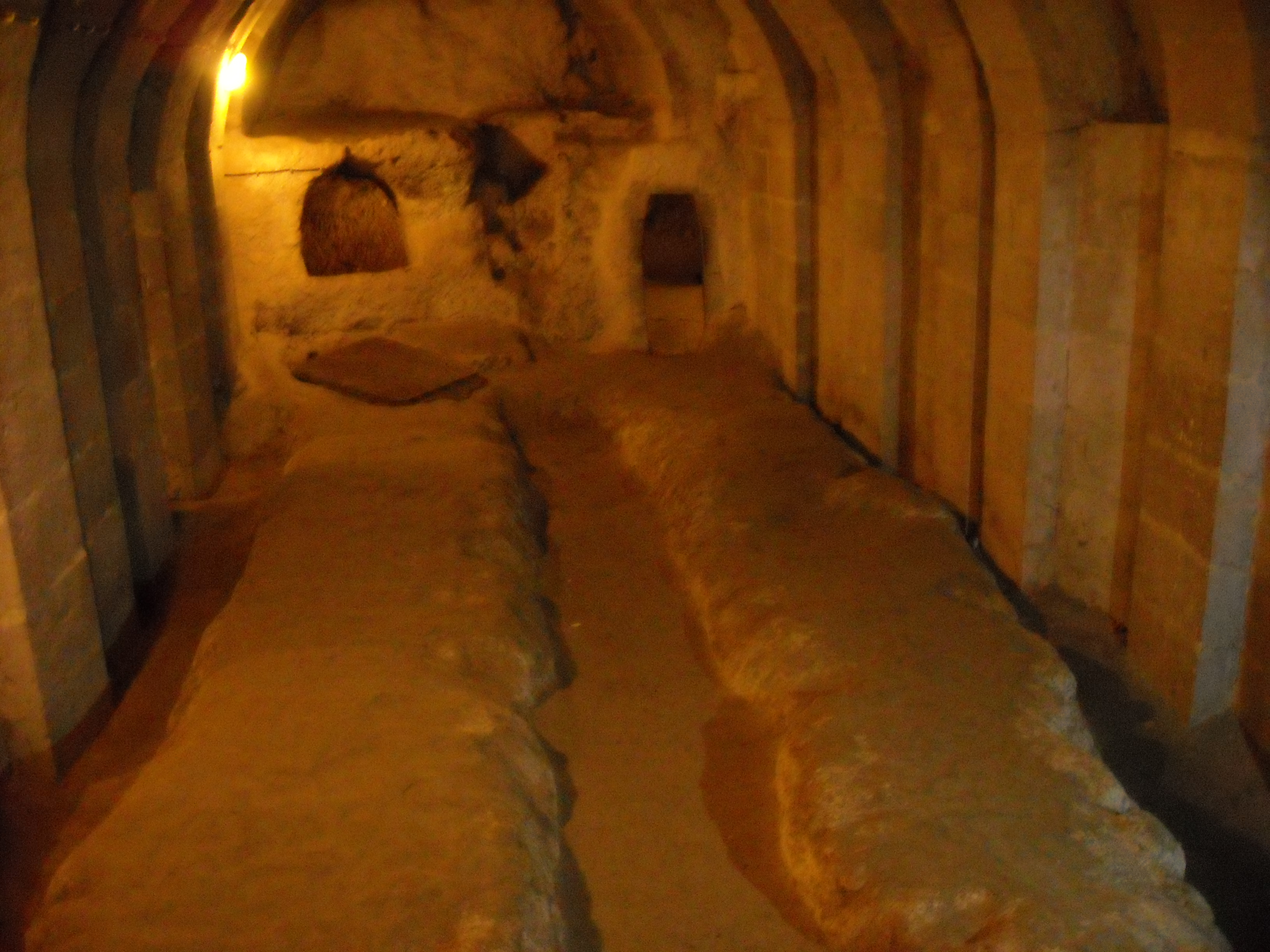 The second underground city, Kaymakli, was more interesting than the first city (or so I thought). It was much easier to imagine people living in the second city. There were more rooms for living and storing. Also, the rooms seem to break off in random directions, which gave a more comb like feel instead of the straight through tunnels like the first. Because we were able explore the secondary rooms and tunnels, I felt like there was much to see.
The second underground city, Kaymakli, was more interesting than the first city (or so I thought). It was much easier to imagine people living in the second city. There were more rooms for living and storing. Also, the rooms seem to break off in random directions, which gave a more comb like feel instead of the straight through tunnels like the first. Because we were able explore the secondary rooms and tunnels, I felt like there was much to see. 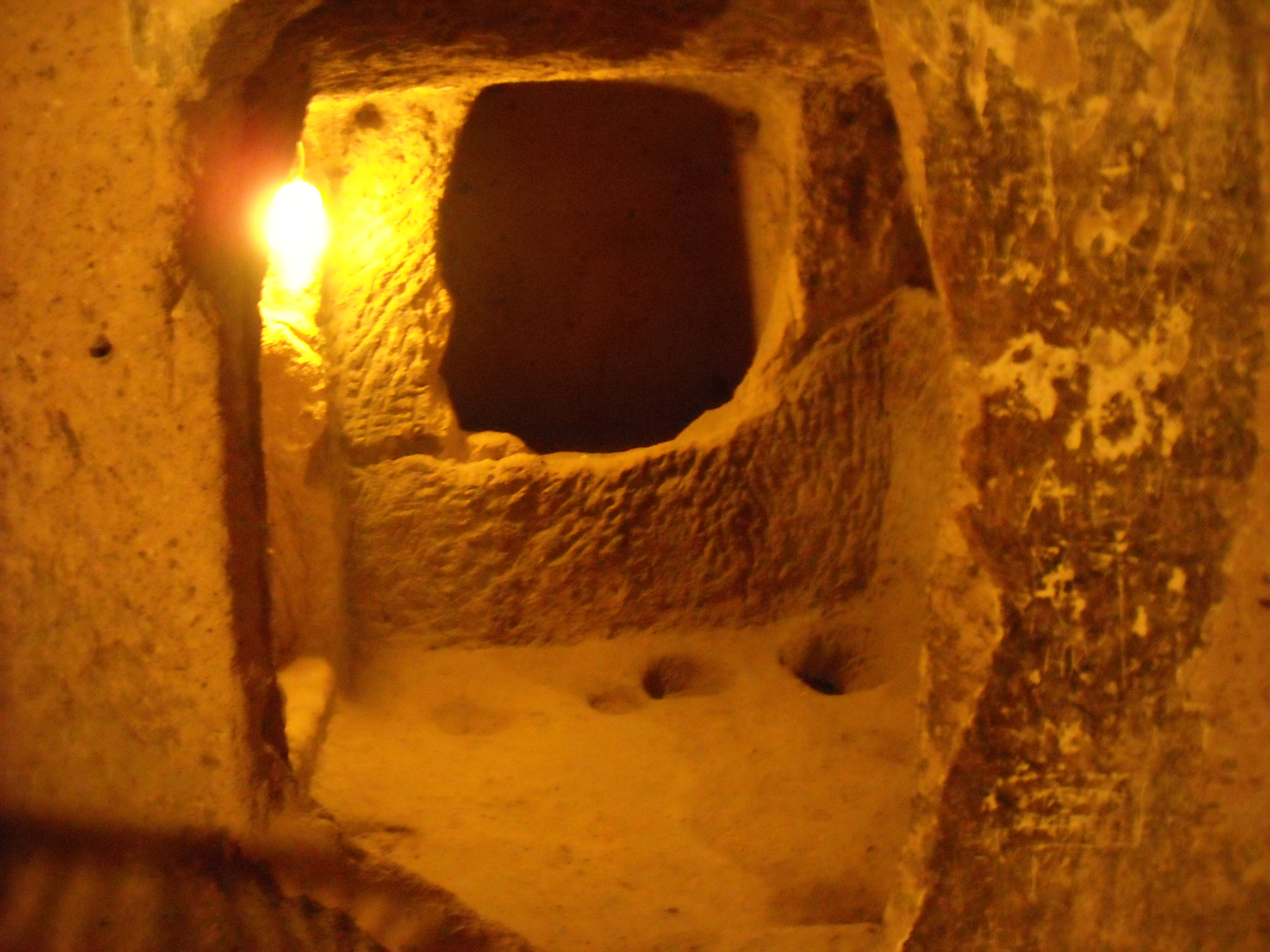 I loved climbing through the tunnels, even if we didn’t know where they went. I also felt like it would have been so easy to get lost in these rooms in the past. I wonder how people were able to climb through without the use of electric lights and flashlights. There were parts of the tunnel that were really small and narrow, which would make it very difficult to walk though holding a torch or something similar. I wonder if people would walk around in the dark, relying on the information they knew about where they lived.
I loved climbing through the tunnels, even if we didn’t know where they went. I also felt like it would have been so easy to get lost in these rooms in the past. I wonder how people were able to climb through without the use of electric lights and flashlights. There were parts of the tunnel that were really small and narrow, which would make it very difficult to walk though holding a torch or something similar. I wonder if people would walk around in the dark, relying on the information they knew about where they lived. 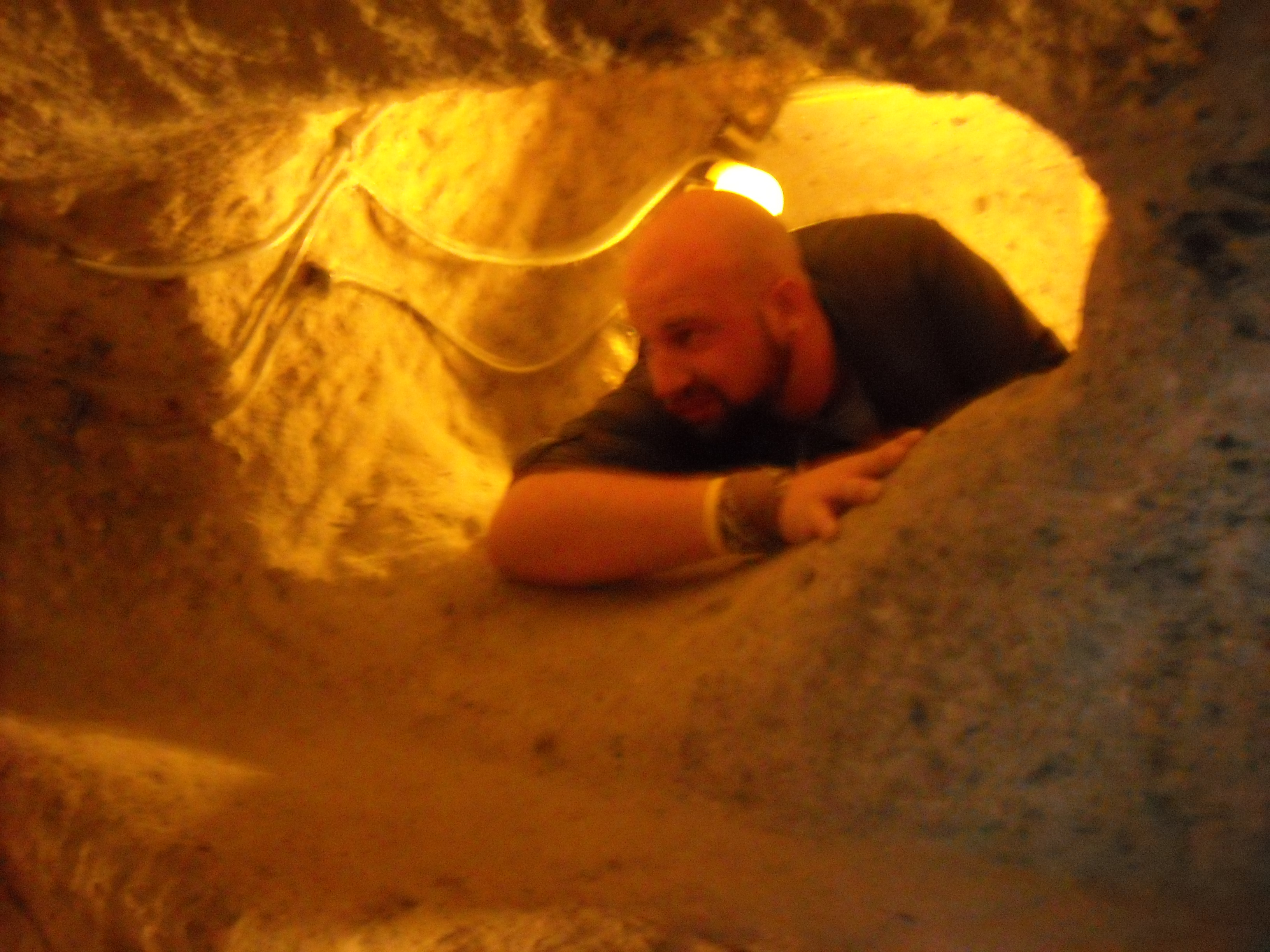 I don’t know if I would ever feel completely comfortable living at a place like this. I would have to bend down a lot to keep myself from hitting my head, and I would be a bit too wide for some of the tunnels we went through.
I don’t know if I would ever feel completely comfortable living at a place like this. I would have to bend down a lot to keep myself from hitting my head, and I would be a bit too wide for some of the tunnels we went through. 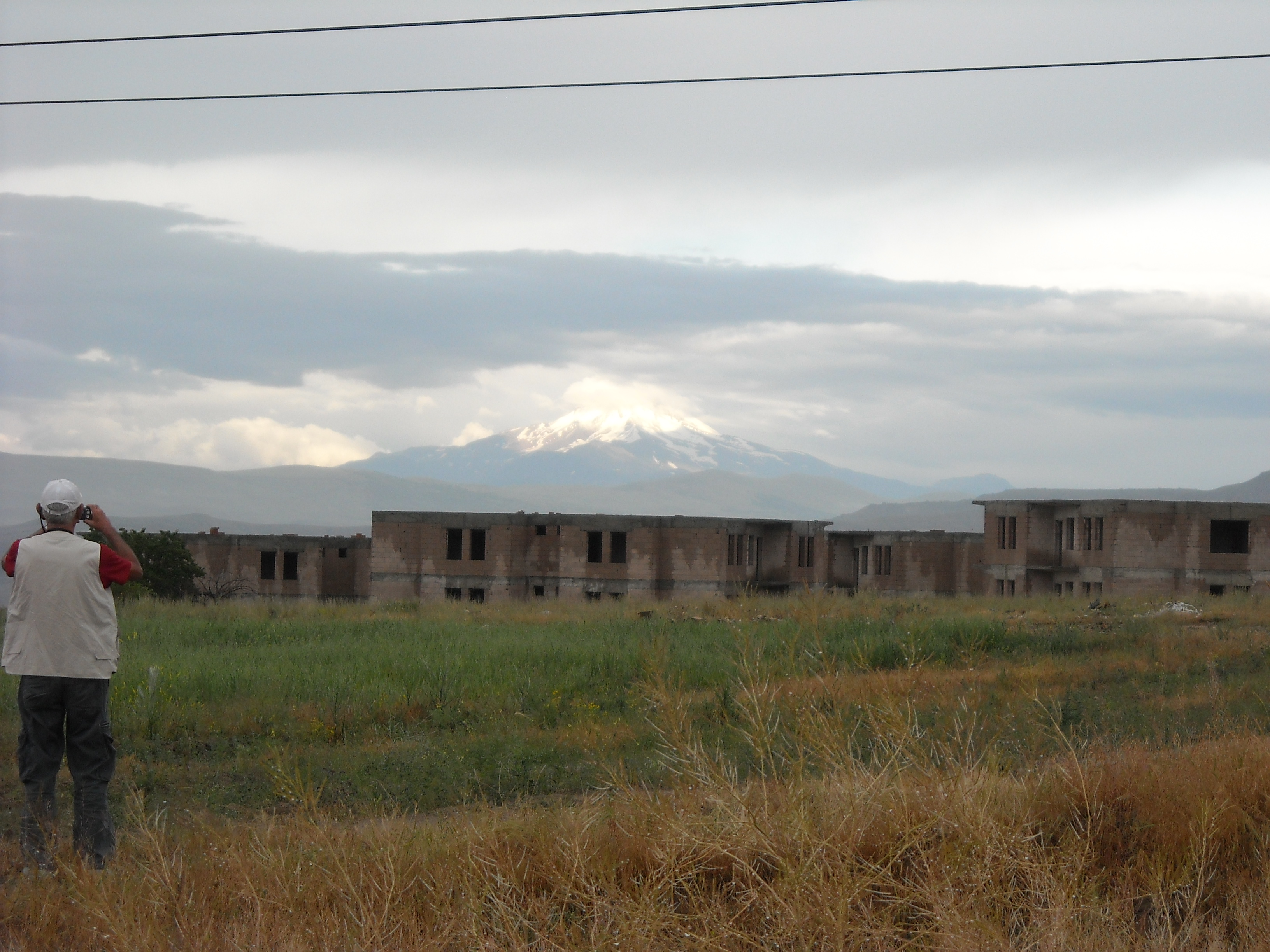
Location: Kilim Otel Dumlupinar Cad. No: 50, Urgup-Neveshir, Turkey
Mexico City
Hola,
So I’m back from Mexico City and it feels so surreal. I can’t believe this is my last week in Mexico. The city was great, but nothing like I expected. We arrived on Thursday and started off the weekend with a great dinner in our Hotel. Then we explored the Zocalo (the historic downtown plaza, otherwise known at the plaza of the constitution) and the area around our hotel. The Zocalo is very cool and huge. It is bordered by the Cathedral to the north, the National Palace to the east, the Federal District buildings to the south, and just to the northeast is the site of Templo Mayor (the remains of the Aztecs’ main temple). In the center is a flagpole with an enormous Mexican flag.
Later that night, we went out to celebrate my friend Anna’s birthday, had some Mexican gelatin cake, and danced like crazy. The next morning, we went to Teotihuacan (which means ‘where men become gods’) to see the pyramids. It was probably one of the most amazing things I have ever seen, and like always nothing close to what I’d expected. The pyramids were enormous and I could almost feel the age in the city. First, we climbed the smaller pyramid, the pyramid of the moon, and from there we could see the whole city. Then, we started the trek up the pyramid up the pyramid of the sun. The view was so amazing. We stayed up there for at least half an hour just relaxing, taking in the view, and taking tons of pictures.
It was crazy how many people were there trying to sell stuff. More than once we were approached by someone claiming their goods were “almost free” and others just wouldn’t leave us alone if we even glanced their way. Then a big group of eighth and ninth graders approached us and started interviewing us in English. At one point I was surrounded by 6 people and was being interviewed by two students at once. Some of them, who didn’t know as much English, didn’t even bother trying to ask the questions, instead they just handed one of us the paper and smiled. Then, they all wanted a photo shoot with us, which was pretty fun.
Afterwards, we went to a huge market downtown with all sorts of good gifts. There was tons of silver, tons of obsidian, many woven blankets, and a ridiculous amount of pottery. It was very overwhelming, but the merchants weren’t nearly as pushy and I had a lot of fun haggling with them. The next day, we started off at the National Museum of Anthropology, which houses one of the best and most important collections in the world. An interesting, and very sad fact, is that most of the works in the museum were replicas because the real artifacts were taken to Europe the moment they were found. It was still really interesting to see all the art, sculptures, and history by the many indigenous groups that once occupied Mexico. After that museum, we went to Frida Kahlo’s house. It was really interesting to see her artwork and photographs spread throughout her house and her things. We were able to see her brace, her x-rays, and many of her self-portraits, and I feel like I learned so much about her in the short time we were there.
After the museum, we went to a nearby market and had some of the best quesadillas I’ve ever eaten. The woman there was truly an artist. She made the tortillas from scratch, filled them, and fried them in record time, and they were delicious. After lunch, we went to Xochimilco, which is home of the famous chinampas. Chinampas are huge rafts that were made by the Aztecs as a means of irrigation. They would fill these rafts with soil from the bottom of the lake and then planted their crops right on the rafts. Over the years, the roots have grown down into the soil, creating canals around the chinampas. Anyway, we spent the afternoon floating down the canals, listening to music, and trying to ignore the venders floating down the river in their own boats. It was so relaxing and really a great way to spend the afternoon.
So that’s all for now, I’ll write again very soon!
Adios,
Lexi
Location: Mexico City, Mexico
Morogoro – Reconnecting with past loves….ecology & environmental science 5-22-10
Today was great! I LOVED the content of today’s lectures. Many people glazed over during the lectures about rural sociology, agriculture and agriculture expansion, mapping patterns of deforestation, forest ecology, and rates and reasons for forest conversion to other land uses at Sokione University. I am very impressed by the quality of this preparatory period. I feel as though we all have a good grasp of the issues in our project area. Tomorrow we will learn more about specific crops in the Morogoro area.
Today was also challenging on a personal level. Just before lunch, during the rural sociology lecture, female circumcision was mentioned as still being practiced and just after that, we learned of a tribe that communicates affection through beatings. During the first three months of marriage, a husband must beat his wife to show he loves her. It is common for women to receive bandages as wedding presents. If a husband does not beat his wife, the wife thinks that he does not love her and she asks him to do it. Patric (guide) says that this practice by very few and small tribes and that men actually exchange some sort of tips on beatings (maybe good, maybe bad….?) This custom is still practiced. Patric has a male friend in this tribe. He says that he has told the friend that he does not need to participate in this custom but the said he will. It is his way of life – his culture. Does cultural preservation dictate the definition of human rights? Is the definition of human rights relative to an individual’s culture?
Location: Morogoro, Tanzania


